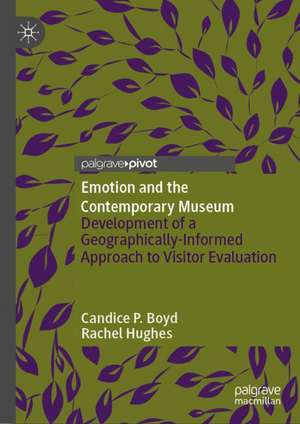Emotion and the Contemporary Museum: Development of a Geographically-Informed Approach to Visitor Evaluation
Autor Candice P. Boyd, Rachel Hughesen Limba Engleză Hardback – 11 iul 2019
Preț: 384.31 lei
Nou
Puncte Express: 576
Preț estimativ în valută:
73.56€ • 79.93$ • 61.83£
73.56€ • 79.93$ • 61.83£
Carte tipărită la comandă
Livrare economică 21 aprilie-05 mai
Preluare comenzi: 021 569.72.76
Specificații
ISBN-13: 9789811388828
ISBN-10: 9811388822
Pagini: 87
Ilustrații: XI, 92 p. 25 illus., 18 illus. in color.
Dimensiuni: 148 x 210 x 12 mm
Greutate: 0.33 kg
Ediția:1st ed. 2020
Editura: Springer Nature Singapore
Colecția Palgrave Pivot
Locul publicării:Singapore, Singapore
ISBN-10: 9811388822
Pagini: 87
Ilustrații: XI, 92 p. 25 illus., 18 illus. in color.
Dimensiuni: 148 x 210 x 12 mm
Greutate: 0.33 kg
Ediția:1st ed. 2020
Editura: Springer Nature Singapore
Colecția Palgrave Pivot
Locul publicării:Singapore, Singapore
Cuprins
Chapter 1 Museology, Cultural Geography, and Non-Representational.- Chapter 2 Exhibiting with Emotion.- Chapter 3 The Museo Laboratorio Della Mente.- Chapter 4 WWI: Love and Sorrow Exhibition.- Chapter 5 Conclusion.
Notă biografică
Candice P. Boyd is an artist-geographer and Research Fellow in the School of Geography, University of Melbourne. Her interests are in therapeutic spaces, experiences of rurality, and contemporary museums. She is author of Non-Representational Geographies of Therapeutic Art Making and co-editor of Non-Representational Theory and the Creative Arts, both with Palgrave Macmillan.
Rachel Hughes is Senior Research Fellow in the School of Geography at the University of Melbourne, Australia. Her interests are public memory and museums in Cambodia, critical geopolitics, and geographies of international criminal justice. She is co-editor of Observant States with I.B. Tauris.
Textul de pe ultima copertă
This book outlines a geographically-informed method of evaluating the emotional impact of museum exhibits. The authors have personally developed the method they describe over several years of working with the Museo Laboratorio della Mente in Rome and the Melbourne Museum in Australia. Informed by non-representational theories in cultural geography, this book offers solutions to museum staff for how they might evaluate aspects of visitor experience, such as emotions and embodied experience, which can be very difficult to assess using conventional approaches.
Caracteristici
Offers a groundbreaking new method of evaluating the emotional impact of museum exhibits on their visitors Developed over several years of working closely with two international museums – The Museo Laboratorio della Mente in Rome and the Melbourne Museum in Australia Provides cutting-edge solutions to staff working in museums as to how they might evaluate aspects of the visitor experience, such as emotions and embodied experience, that are very difficult to assess using conventional approaches Affirms the potential for future collaborations between cultural geography and museum studies – examples of such collaborations in the literature are rare
